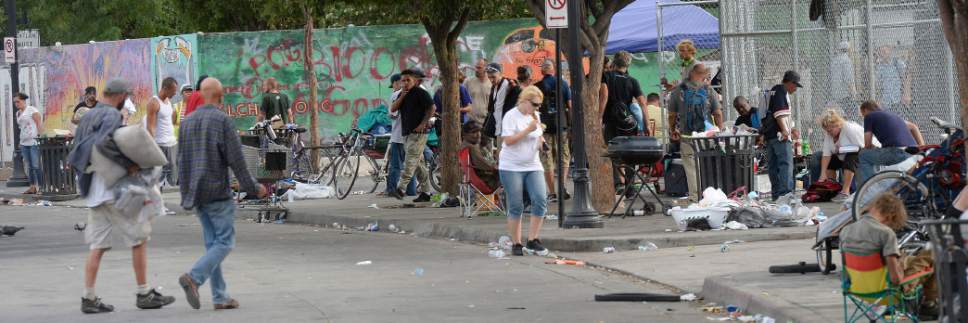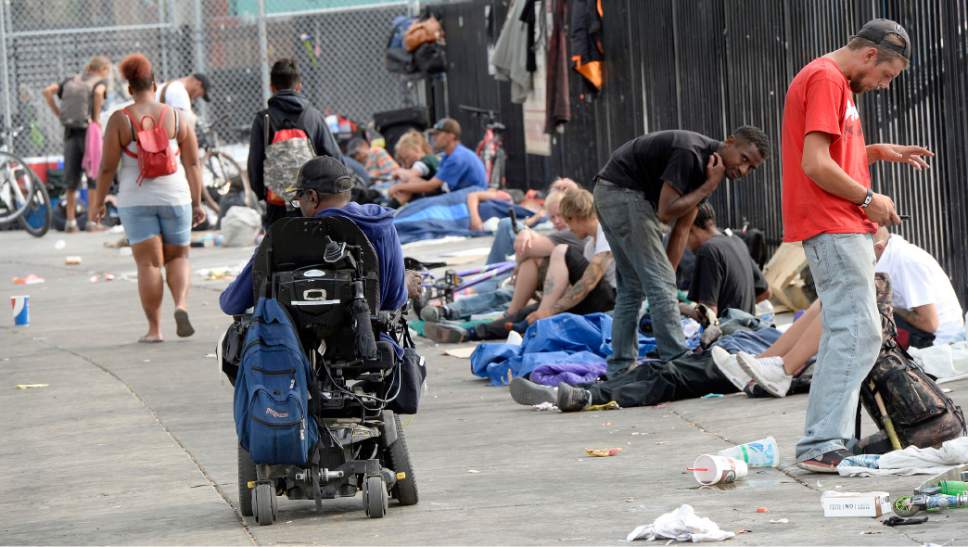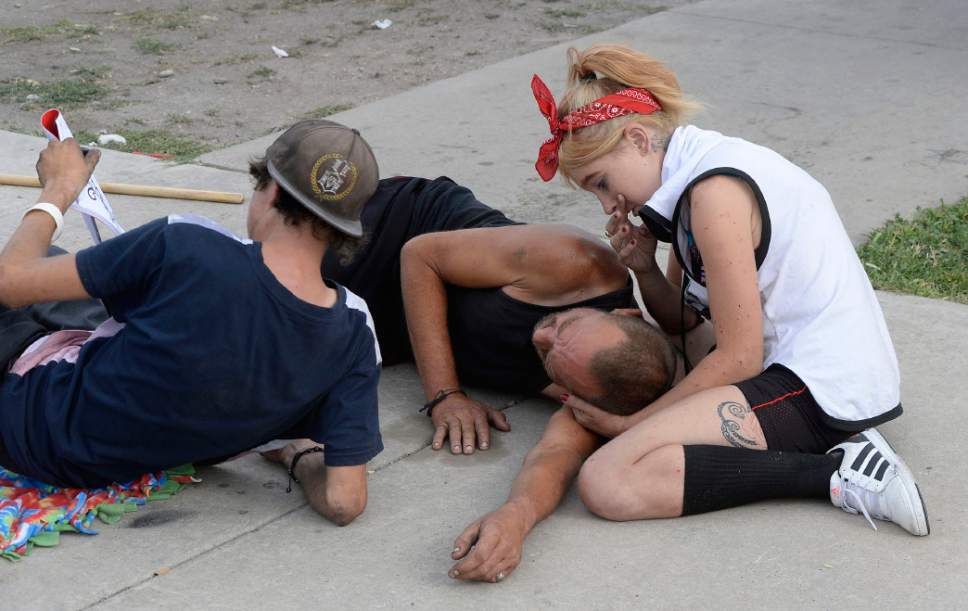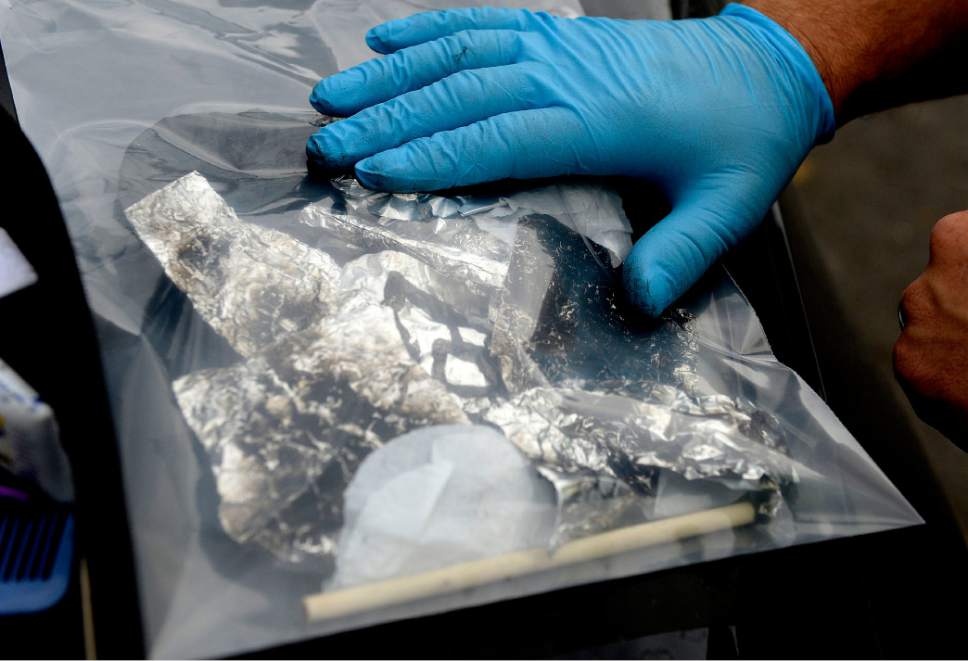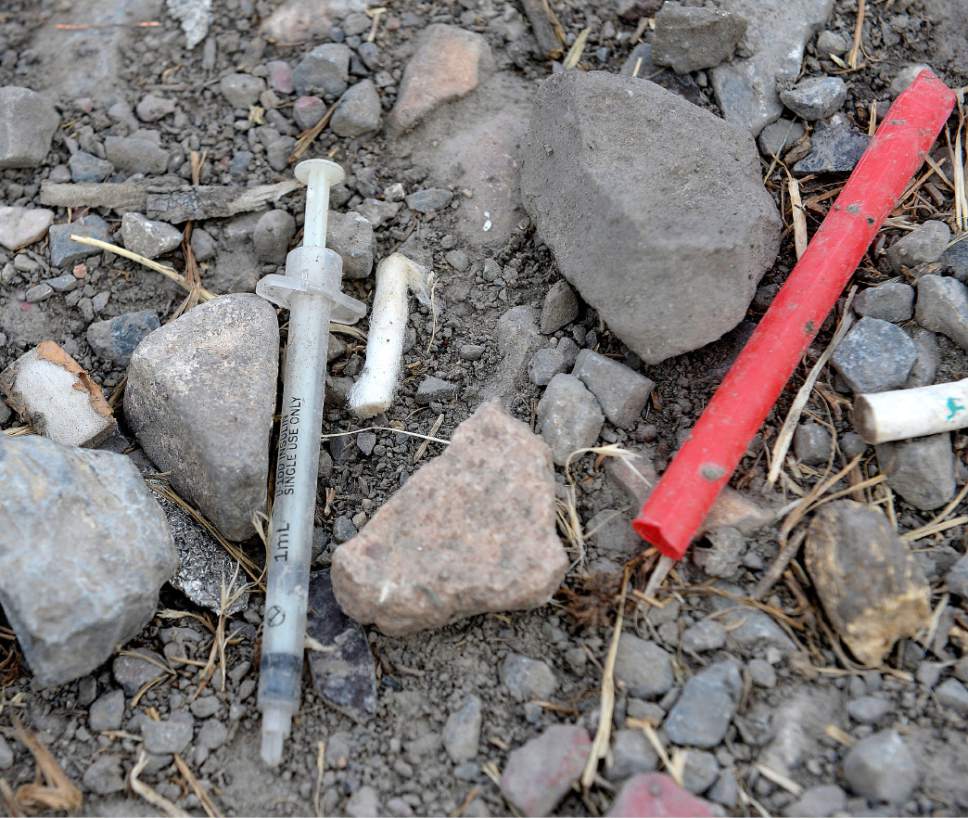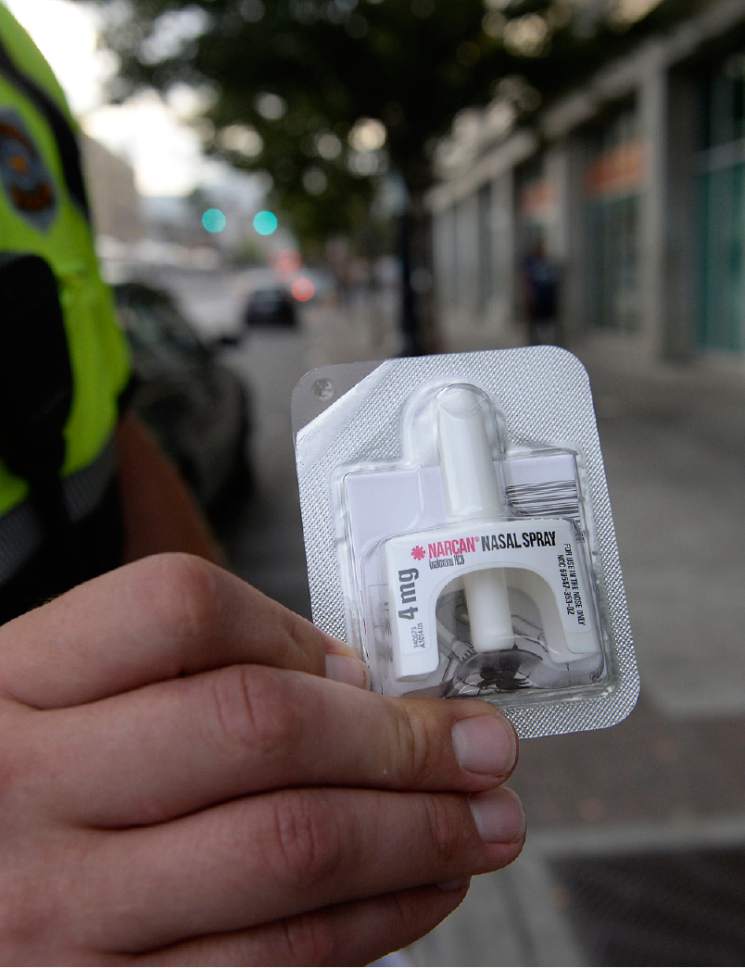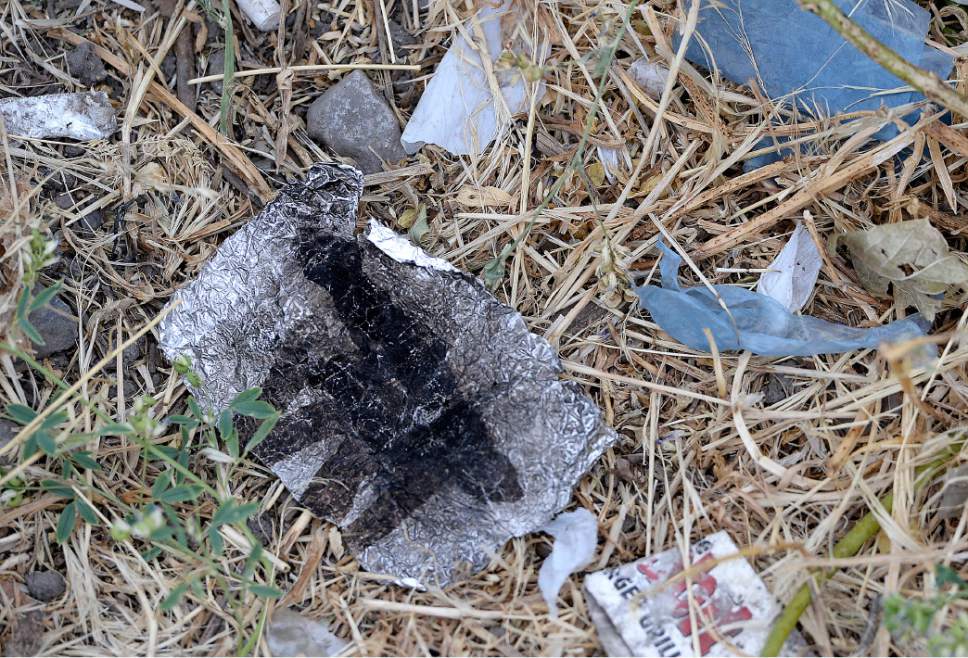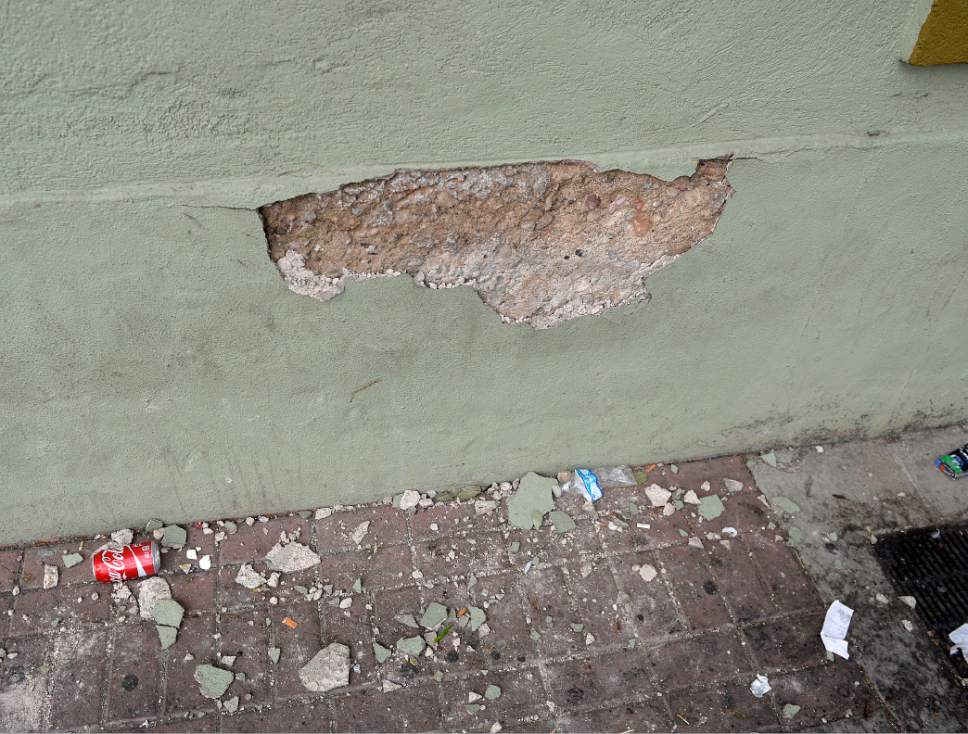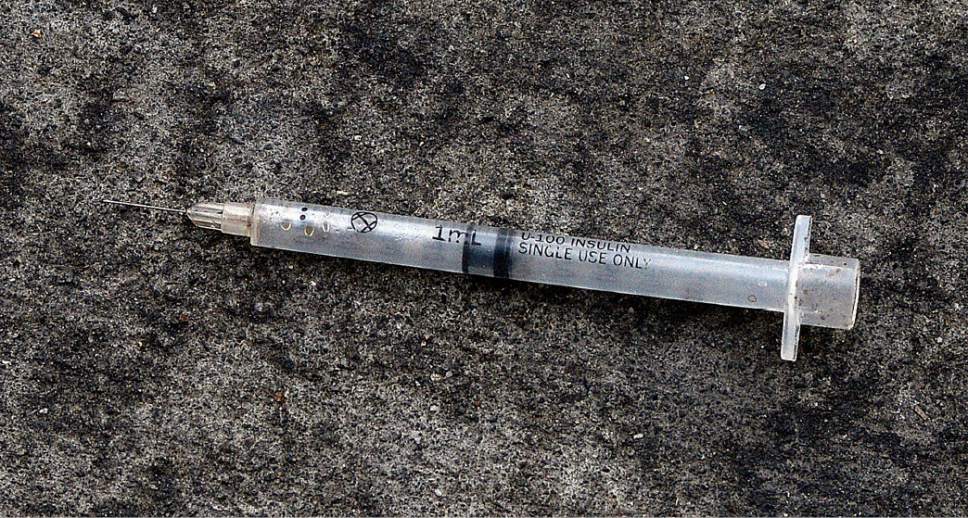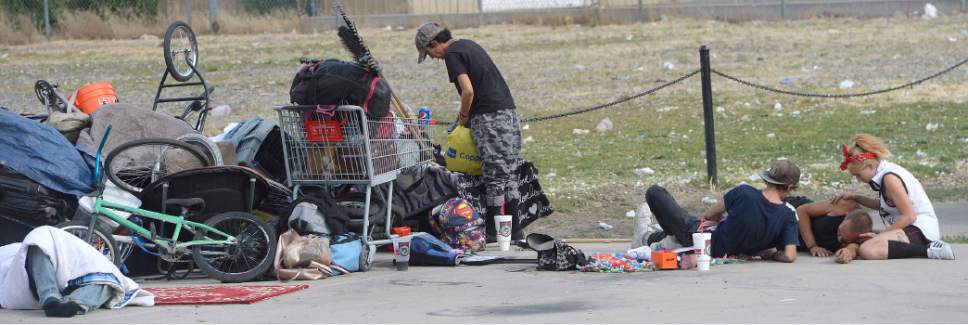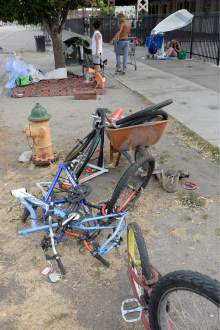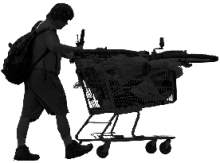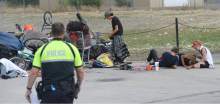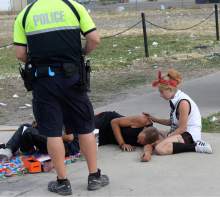This is an archived article that was published on sltrib.com in 2017, and information in the article may be outdated. It is provided only for personal research purposes and may not be reprinted.
The area around Pioneer Park and Rio Grande Street's homeless shelter has long been a place to score illegal drugs. Crack cocaine, methamphetamine and alcohol were the substances of choice until about 2013 or '14. Then heroin swept in and amped up everything.
It's no longer a drug deal here and there. Now, drugs are passing hands nonstop, 24/7. It is not uncommon to see addicts shooting up in broad daylight.
Residents and business owners complain of discarded needles, human waste, garbage, prostitution, violence.
Addiction has shoved women and men out of jobs, out of homes and onto the street in a never-ending chase for the next fix. Of the 300 or so who camp out in the area during warm months, at least 80 percent use heroin, said police Sgt. Sam Wolf.
"These people have hit rock bottom," he said. "They have nothing left."
The opioid epidemic and the concurrent surge in heroin trafficking make solving homelessness in the Rio Grande district much more complex.
Folks down on their luck looking for a roof have gathered on Rio Grande Street in Salt Lake City's downtown for more than three decades. But only in recent years has it become a nasty hub of drug dealers and addicts who pose a danger to shelter clients and passers-by — shootings in the shadows from drug deals gone bad, nighttime bludgeonings over turf and people overdosing on hot sidewalks under the bright sun.
Traditionally, issues involving housing, employment and health care have spawned swift currents that people on the lower economic rungs struggle against, and all three remain major issues, particularly with the cost of apartments rising in the Salt Lake Valley. But homelessness is not up significantly over the past several years, according to state data.
Yet many observers say the lawlessness, drug use and squalor around The Road Home, the shelter located at 210 S. Rio Grande St. (450 West), have never been so prevalent.
During the past four years, the opioid epidemic, fueled by prescription drugs that lead many to heroin, has surged into the area, as it has in many locales across the country. It has upended decades of work by local, state and federal agencies, as well as a multitude of private entities, seeking to help the state's homeless population.
The Rio Grande neighborhood has never been this troubled, according to longtime advocate Pamela Atkinson.
"The long-term plans are great," she said, referring to three proposed new homeless shelters/resource centers and programs that won't open their doors for at least two years. "But we need immediate action down there. We need an action plan to come up with ways to keep drug dealers from using the area."
There are hundreds of addicts living in the shelter or camping nearby.
"Some people have told me, 'I like being on drugs. Leave me alone,' " Atkinson said. "There is a certain group who say they aren't going anywhere and that group is growing."
—
The law and the lawlessness • On Wednesday, Gov. Gary Herbert announced a new plan would be implemented to curb the chaos and lawlessness there. Details remain sketchy, but the governor said the state is ready to spend more money for cops.
In a previous interview, Salt Lake City Police Chief Mike Brown emphasized that "homeless people aren't driving the drug trade. They don't have the money."
He said Utahns who aren't homeless, as well as people from as far away as Wyoming and Idaho, come to score drugs in the Rio Grande area, particularly along 500 West.
Nonetheless, addicts living in the area provide the chaotic environment that allows drug dealing to thrive, and a growing number of them are women.
Some of the female street addicts sell sex for a dose of heroin, Wolf noted.
"They prostitute themselves for a little bit of dope," Wolf said. "It takes a mental toll on them. They've made that choice, and it tears them up emotionally."
Last week, police arrested a 20-year-old woman just before she was going to shoot up. She told The Salt Lake Tribune her name was Meresa and that she had been on the street since she was 16. She was gaunt with blotchy skin and sat in the back of a patrol car in handcuffs weeping.
Some people become addicted to pain pills prescribed by a physician. At some point, they may seek pills on the black market, fall into homelessness and turn to heroin, according to service providers. Some 45 percent of heroin users became addicted to prescription opioids first, according to the U.S. Centers for Disease Control and Prevention.
Others who experiment with drugs recreationally fall prey to heroin with similar results, according to law enforcement. And some who weren't drug users, but found themselves at the shelter, take up drugs to alleviate the stress of their predicament and become addicted. Either way, homeless addicts find it difficult to get off the street.
Although the United States comprises 5 percent of the world's population, it accounts for 80 percent of global opioid consumption, according to The Washington Post.
Some 7,000 prescriptions for opioid painkillers are written every day in Utah, said Jason Mathis, executive director of the Downtown Alliance business group.
"The medical community is as culpable as anyone," he said, "including the drug cartels."
And those drug cartels are more organized than ever, according to law enforcement officials. They use cellphones to coordinate buys, avoid arrest by using runners who are addicts, and have access to a staggering flow of heroin. When a dealer is busted by police, Wolf said, others are soon on the scene to fill the void.
Compounding the uncertain environment around the shelter is that people who suffer from untreated mental illness often end up there and turn to street drugs to self-medicate.
A Salt Lake County survey of 586 people living in and around The Road Home in November revealed that 30 percent said they suffered from behavioral problems.
About a third of those surveyed said they had been in jail in the past six months. Half those surveyed said they were from out of state.
—
To jail or not to jail? • In June, former Salt Lake County Sheriff Jim Winder withdrew a year-old jail restriction that barred booking misdemeanor suspects.
Salt Lake City police had complained that miscreants around Rio Grande Street knew they would not be arrested for anything less than a felony and used drugs openly. Prostitution, a class A misdemeanor, flourished, as well.
Earlier this year, the Legislature provided funding for 300 beds at jails in outlying counties to make way for more arrests. But, to date, only 30 beds at the Tooele County jail have become available.
Winder withdrew the year-old restrictions grudgingly. He says society cannot arrest its way out of drug addiction.
"They go back to the same environment that fundamentally hasn't changed," he said of drug users after they are released from jail. "The premise that the Rio Grande area is a location to provide help is a myth."
The former sheriff went further, saying The Road Home and service providers are enabling drug addicts who are not seeking a way back to productive society. They have a place to stay, plenty to eat, free clothing, medical care and easy access to drugs.
"Salt Lake City has become the absolute parent with the 40-year-old kid living in the basement," he said. "A community gets exactly what it tolerates."
By contrast, Brown, Salt Lake City's police chief, said the community must treat the homeless with dignity, no matter whether they are addicted or mentally ill, though he maintains it is important for officers to be able to arrest people who are openly using drugs. It makes the environment better and gives jailed addicts a pause to reflect upon their circumstances.
"When we arrest these folks," he said, "we need to get them into court and get them the treatment they need."
During the past year, Salt Lake City and Salt Lake County teamed up in Operation Diversion: Law enforcement officials arrested people committing crimes, and then the district attorney's office offered them the option of treatment or jail.
The effort has been less than a huge success, Brown said.
Of the 68 people "diverted" from jail beds to treatment beds in three sweeps, six had graduated and 54 had fled by mid-May.
However, the City Council earlier funded eight social worker positions within the police department. These social workers help willing homeless people get into treatment. Since 2015, they have worked from the Community Connection Center on the corner of 200 South and 500 West. From October 2015 to June 30, 236 volunteer walk-ins have sought treatment. That group has about a 50 percent success rate, according to the police chief.
Nonetheless, about 100 addicts seeking treatment have been turned away for lack of beds, said Matthew Rojas, spokesman for Salt Lake City Mayor Jackie Biskupski. In the past several months, four of them have died, he said.
In 2016, arrests were up and crime down nearly 6 percent in the area from the previous year. After becoming chief in June 2015, Brown beefed up bicycle patrols — 67 officers now ride through the area.
According to police stats, over 189,000 doses of drugs valued at $1.5 million were seized in the area in 2016 — a jump of 58 percent over 2015.
But there remains no shortage of heroin on the streets, according to patrol officers.
And the violence is still unpredictable. Over the Fourth of July holiday, a visiting professional baseball player was assaulted by a homeless man, and a woman drove her car into a half-dozen homeless people, killing one.
Alarm bells were sounded — again — this time by Utah House Speaker Greg Hughes, R-Draper. Things must change in the Rio Grande district, he said, and fast.
Two more homicides in the area on July 25 and 26 punctuated Hughes' call to action.
Nobody disagrees. But such warnings have gone up before.
—
There are solutions • Four years ago, at the onset of Rio Grande's epidemic, Mathis implored the City Council to ratchet up funding to address the climate there, which, he said, was deteriorating rapidly.
In the ensuing four years, the city and county, along with private-sector providers, have made strides at coordinating efforts that have been successful in getting nonaddicts back into homes.
Although the number of homeless people remains relatively unchanged — hovering around 3,000 on any given day — those seeking services from providers in 2016 equaled 13,614. Among other things, that means people are moving in and out of homelessness, said Jonathan Hardy, director for the state Division of Housing and Community Development.
State data also reveal the average stay in the shelter is 46 days. For most clients of The Road Home, homelessness is a temporary obstacle. The vast majority find help from service providers and get back on their feet.
But the tide of opioid and heroin has upstaged those positive strides. When addicts are willing, there are solutions to the combined problem of homelessness and drugs.
Through a philosophy called "Housing First," addicts and those suffering from mental illness are placed in apartments in Salt Lake City in what is called "permanent supportive housing." Caseworkers direct them to various resources and treatment options and follow up on their progress.
The philosophy holds that once people are stabilized, they can regain sobriety and mental health. There are about 2,000 such "permanent supportive housing" units in Salt Lake County.
Housing First has been successful, said Michael Gallegos, Salt Lake County director of Housing and Community Development. But no new permanent supportive housing units are being built. And vacancies open up only occasionally.
Not only has Housing First been pushed to the back burner, but folks seeking treatment for addiction or mental health issues find a dearth of inpatient treatment centers. That is due partly to the way the state responded to the Affordable Care Act's expansion of Medicaid. State leaders didn't want to accept the broader Obamacare program and instead sought a limited waiver. They've been unsuccessful, losing out on tens of millions of dollars to treat addiction and mental illness.
Utah is poised to apply again for money that would provide treatment for as many as 6,000 people suffering from mental disorders and addiction.
Such funding could be critical as Salt Lake City and the county move to the scattered-site model for three new resource centers. The planned emergency shelters that would coordinate services for clients are expected to house a total of about 700 people — 400 less than The Road Home can now accommodate. The proposed system, however, is not designed for homeless people who are addicts or who need mental health therapy.
That makes the federal Medicaid waiver funding key to success in the new model. Presently, the lack of funding for treatment beds leaves a big question mark hanging over the success of that strategy and what homelessness will look like in Salt Lake City in the years to come.
Editor's Note: An earlier version included an incorrect number for the homeless people who are expected to be served by three planned resource centers.






